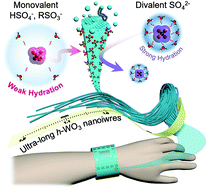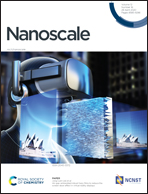Monovalent sulfur oxoanions enable millimeter-long single-crystalline h-WO3 nanowire synthesis†
Abstract
Here, we discuss a misunderstanding regarding chemical capping, which has intrinsically hindered the extension of the length of hexagonal (h)-WO3 nanowires in previous studies. Although divalent sulfate ions (SO42−) have been strongly believed to be efficient capping ions for directing anisotropic h-WO3 nanowire growth, we have found that the presence of SO42− is highly detrimental to the anisotropic crystal growth of the h-WO3 nanowires, and a monovalent sulfur oxoanion (HSO4−) rather than SO42− only substantially promotes the anisotropic h-WO3 nanowire growth. Ab initio electronic structure simulations revealed that the monovalent sulfur oxoanions were preferentially able to cap the sidewall plane (100) of the h-WO3 nanowires due to the lower hydration energy when compared with SO42−. Based on this capping strategy, using the monovalent sulfur oxoanion (CH3SO3−), which cannot generate divalent sulfur oxoanions, we have successfully fabricated ultra-long h-WO3 nanowires up to the millimeter range (1.2 mm) for a wider range of precursor concentrations. We have demonstrated the feasibility of these millimeter-long h-WO3 nanowires for the electrical sensing of molecules (lung cancer biomarker: nonanal) on flexible substrates, which can be operated at room temperature with mechanical flexibility with bending cycles up to 104 times due to the enhanced textile effect.



 Please wait while we load your content...
Please wait while we load your content...